By Peter J. Koehler
Longue conversation avec Charcot. C’est bien ce que je pensais. J’en ai pour la vie. Cela ne m’a pas porté le coup que j’aurais dû attendre.
[Long conversation with Charcot. It is indeed what I thought. I will have it for life. It did not bring the blow that I would have expected.]
These are the words written in a notebook by French novelist Alphonse Daudet (1840-1897) and published posthumously in a book (La Doulou, 1930, p. 18) with short statements he had made during the 20 years he was suffering from ataxie locomotrice progressive (tabes dorsalis).
As probably most neurologists will know, general paralysis of the insane (GPI, also known as general paresis and dementia paralytica) and tabes dorsalis are the two main neurological manifestations of late neurosyphilis. The first condition was recently discussed by Fiolet and Daey Ouwens in an article on malaria fever therapy and has become relatively rare. (See World Neurology October/November 2020.) The latter disease became very rare during the past decades, and only few living neurologists will ever have observed it.
Shooting Pain
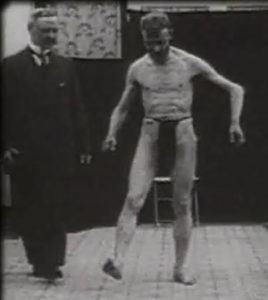
Early 19th-century patient showing wide based gait and hypermetric lifting of right leg. Note the spreading of the arms to keep balance.
In a time that it was much more frequent, a neurological test became associated with it, notably the Romberg Test. It was introduced in a period that this eponymist will not have realized that it was a syphilitic disease. With a latency of between 15 and 30 years after the primary infection, the shooting pain in the legs and abdomen were the most characteristic symptoms, next to signs such as ataxic gait. In old neurological films, these patients are easily recognized by their wide-based gait with hypermetric lifting of the feet.
Another characteristic sign was the Argyll-Robertson pupil. These could be accompanied by absent muscle stretch reflexes of the lower limbs, a sign that was already believed to be of great importance, when the reflexes were described by Westphal and Erb (1875). As would be expected, pathology in these patients was found in the dorsal roots and posterior columns in the lower part of the spinal cord, while, of interest, the exact pathogenesis is unknown.
The Term
The term tabes is quite old, meaning consumption. In the past, the Greek term phtisis was used to indicate consumption, in particular when it was caused by tuberculosis of the lungs. The term dorsalis, as one would expect, does not refer to the dorsal columns, but rather to the affliction of the spinal cord. The neurologist and “neurohistorian” Francis Schiller (1909-2003) noted that it was already referred to in the Hippocratic corpus, where consumption of the spinal cord is mentioned (phtisis notias).
Romberg’s Test
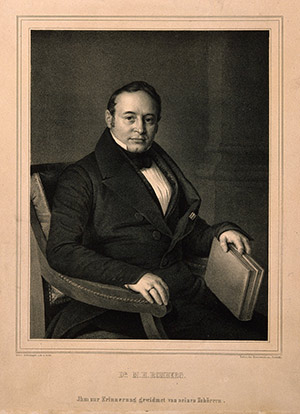
Moritz Romberg (Humboldt-Universität zu Berlin, Universitätsbibliothek).
Probably most neurologists will be acquainted with this test, described in the early 1840s by the Berlin physician Moritz Heinrich Romberg (1795-1873) in his well-known Lehrbuch der Nervenkrankheiten des Menschen. He had observed the phenomenon in patients suffering from tabes dorsalis and wrote:
Isolirt, ohne Verlust des Hautgefühls, zeigt sich die Anaesthesia muscularis, nach meinen Beobachtung, als stete Begleiterin der Tabes dorsualis. Ein einfaches Experiment giebt davon die Ueberzeugung. Man lässt den Kranken in aufrechter Stellung die Augen schließen: sofort tritt ein Schwanken des Körpers ein, und nimmt dergestalt zu, dass derselbe, wenn man ihn nicht hält, umsinkt. 2, p.228
In the English edition of Romberg’s second German edition, this was translated as:
I have observed that anaesthesia of the muscles alone without loss of tactile power, invariably accompanies tabes dorsalis. A simple experiment suffices to determine the fact. If the patient is told to shut his eyes while in the erect posture, he immediately begins to move from side to side, and the oscillations soon attain such a pitch that unless supported he falls to the ground., pp. 226-7
Romberg believed the sign was pathognomonic:
Auf dieses pathognomonische Merkmal — denn es zeigt sich nach meiner Beobachtung weder bei andern Lähmungen noch in der von Complication freien Amaurose — habe ich schon vor zehn Jahren aufmerksam gemacht …2, p.795
[It is now 10 years since I pointed out this pathognomonic sign, and it is a symptom which I have not observed in other paralyses, nor in uncomplicated amaurosis; since then I have found it in a considerable number of patients, from far and near, who have applied for my advice; in no case have I found it wanting].p. 396
It is interesting to note that Romberg wrote about “paralyses” and inserted the chapter on tabes dorsalis in a section on spinal paralyses.2, pp.794-801
Muscle Sense
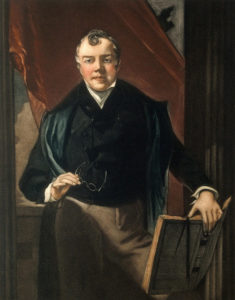
Charles Bell (Colour mezzotint by H. Goffey after J. Stevens. Wellcome Collection).
Romberg observed an autopsy at the Berlin Charité hospital, done by his colleague Robert Froriep (1804-1861) and was particularly interested in the atrophy of the caudal part of the spinal cord, including the dorsal columns and the dorsal roots. “Die Marksubstanz der erstern war fast ganz geschwunden, so dass sie wie durchsichtig von graugelber Farbe erschienen”.2, p. 799 [The medullary tissue of the former had almost entirely disappeared, so that they were translucent, and of a greyish-yellow colour].4, p. 399
Years before, Romberg had translated English medical books into German, including Scottish surgeon and anatomist Charles Bell’s (1774-1842) The nervous system of the human body (1830). Bell was the person, who gave an early description of proprioception (the sixth sense) in 1826: “between the brain and the muscles, there is a circle of nerves…”
As this subject had also been a part of Romberg’s translations (1832), he was aware of muscle sense, as appears from his textbook: “Verlust des specifischen Muskelgefühls, die Kehrseite des Schwindels, als dessen Grundzug Empfindung von Scheinbewegungen aufgestellt worden, kommt entweder in Verbindung mit Anaesthesia cutanea oder isoliert für sich vor. Von ersterem erzählt Bell ein Paar Beispiele”.2, p. 226 [A loss of the specific muscular sensation, the counterpart to vertigo, the fundamental character of which has been stated to be an impression of illusory movement, may occur in connection with anaesthesia cutanea or isolated. Bell relates a few instances of the former].3, p. 225
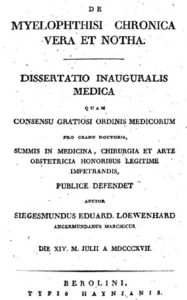
Thesis of Sigmund Eduard Loewenhard (1817).
The French physician Guillaume BA Duchenne (1806-1875) applied the term ataxia, mentioning the disease “ataxie locomotrice progressive” [progressive locomotor ataxia]. Moreover, he doubted the muscle weakness, as described by Romberg, and emphasized the disorder of balance and coordination that increased in the dark.
Wide-Based Gait and Shooting Pain
Romberg was not the first physician to describe tabes dorsalis. His teacher Ernst Horn (1774-1848) wrote about it in 1813, and some of Horn’s pupils published dissertations on the disease in the early 19th century. De Myelophtisi Chronica Vera et Notha (1817), for instance, was written by Sigmund Eduard Loewenhard (1794-1875) . Like Romberg, they also supposed weakness, but the wide-based gait was the most remarkable feature. They also noted the genu recurvatum or knee hyperextension and were aware of the shooting pain in the limbs, urinary incontinence, and impotence.
Argyll-Robertson Pupil
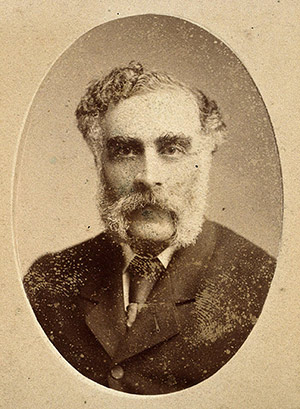
Douglas Argyll Robertson (Wellcome Collection).
Romberg had already noted the peculiar disorder of the pupils. “in der Tabes dorsualis dagegen habe ich öfters die Pupille bis auf die Größe eines Stecknadelknopſes contrahirt gefunden”2, p. 684 [in tabes dorsalis I have found the pupil contracted to the size of a pin’s head]4, p. 299 and “in beiden Augen oder nur in einem, und zwar eine Verengerung mit Unbeweglichkeit”.2, p. 797 [one or both eyes, consisting in a contraction with loss of motion]4, p. 397
Scottish surgeon and ophthalmologist Douglas MCL Argyll Robertson (1837-1909) later provided an accurate clinical description of the characteristic, narrow, not completely round pupil that reacted to convergence, but not to light (1869). His students are supposed to have said: “It’s better to be pupil of Argyll Robertson than to have them.”
Charcot’s Contributions
In his early career, Jean-Martin Charcot (1825-1893) in cooperation with Alfred Vulpian (1826-1887) published some cases (1862) and later he described the condition more extensively with his pupil Charles Bouchard (1837-1915), emphasizing the severe pain with the term “douleurs fulgurantes” [shooting pains]. Moreover, he described the arthropathy, later eponymized as Charcot joints, that could accompany the disease.
As for the treatment, he applied suspension therapy, applied 20 years later. He referred to “Dr. Motschutkovsky de l’Odessa,” who had observed a favorable effect on the pain. Charcot, with his pupil Georges Gilles de la Tourette (1857-1904), treated a number of patients by this method, including his rear neighbor the writer Alphonse Daudet. As mentioned in the introduction, book on his disease, in particular the pain, was published posthumously, notably La Doulou (La Douleur/The pain; 1930, English translation in 2002); This is what he noted on this particular treatment:
Je reste jusqu’à quatre minutes en l’air, dont deux soutenu seulement par la mâchoire. Douleur aux dents. Puis, en descendant, quand on me détache, horrible malaise dans la région dorsale et dans la nuque, comme si toute ma moelle se fondait. (La Doulou, 1930, p. 23)
[I stay in the air up to four minutes, two of which supported only by the jaw. Pain in the teeth. Then, descending, when they detach me, a horrible malaise in the dorsal region and in the neck, as if the whole cord is melting.]
Intemperance in Baccho et Venere
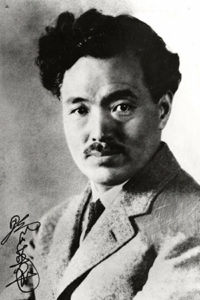
Hideyo Noguchi.
Interestingly, although the venereal origin of tabes dorsalis was not known in Greek antiquity and the centuries that followed, the association with (excessive) sexual activity and sin was supposed. A relation between sexual activity and the spinal marrow, also known as the encephalomyelogenic spermatology, was assumed. The association has been repeatedly mentioned by persons including Plato (c 427 -347 BCE; Timaeus), Leonardo da Vinci (1452-1519), and the Swiss physician Théophile Bonet (1620-1689).
Herman Boerhaave (1768-1838) wrote about excessive loss of sperm that could produce fatigue, debility, immobility, convulsions, wasting, and drying up, leading to dorsal consumption (tabes dorsalis). The spinal cord had traditionally been linked to the production of semen, and therefore excessive sexual activity was associated with tabes dorsalis by physicians including the Leyden professors Boerhaave and Hiëronymus David Gaubius (1705-1780), to whom the Swiss Samuel-Auguste Tissot (1728-1797) referred in his well-known L’Onanisme (1764).1 In Romberg’s time, it was considered an affliction of men, nearly one eighth of the patients being women. He wrote about physical exercise followed by “Excesse in Baccho et Venere.”
Uebermässiger Aufwand motorischer Kraft durch anhaltendes Stehen in gebückter Stellung, durch forcirte Märsche bei gleich zeitiger Erkältung in ſeuchten Bivouacs etc. und darauffolgende Excesse in Baccho et Venere – wie es so häufig in Feldzügen der Fall ist – spielen in der Aetiologie eine wichtige Rolle, daher die Frequenz der Tabes dorsualis in den ersten Decennien nach den grossen Feldzügen neuerer Zeit. 2, p. 800-1
[When the strength is much taxed by continued standing in a bent posture, by forced marches, and the catarrhal influences of wet bivouacs, followed by drunkenness and debauchery, as is so often the case in campaigns, the malady is rife; this is the reason why tabes dorsalis was so frequent during the first decennia following the great wars of the present century.4, p. 400]
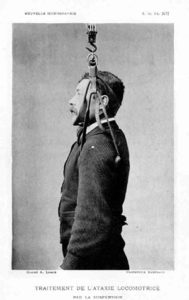
Suspension treatment (from article by George Gilles de la Tourette Nouvelle Iconographie 1889, p. 88-9).
Therefore, long journeys to health resorts, to undergo hydrotherapy as a form of prevention for instance, was dissuaded. The prognosis was believed to be serious without prospect of recovery, although the course could be quite long.
Venereal Disease After All
Due to the long latency between infection and tabes dorsalis (or GPI), it took a long time before the association was proved. Jean-Alfred Fournier (1832-1914), the French dermatologist, who was specialized in venereal diseases, found statistical indications, categorizing both diseases under the term “parasyphilis” (1894). However, he continued the idea of hereditary transmission. Further proof for the association with syphilis was delivered by the German neurologist Wilhelm Heinrich Erb (1840-1921). Biological proof had to wait until 1906, when the Wasserman reaction was described, a year after the discovery by Fritz Schaudinn (1871-1906) and Erich Hoffmann (1868-1959) of the Treponema pallidum. Finally, the Japanese bacteriologist Hideyo Noguchi (1876-1926) demonstrated the spirochete in the brain of a patient suffering from GPI in 1913 and later in the spinal cord of a tabetic patient. •
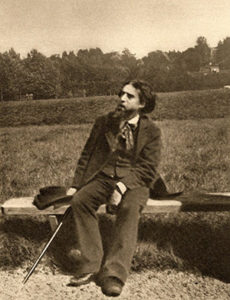
lphonse Daudet, French writer who suffered from tabes dorsalis
References
- Schiller F. Venery, the spinal cord, and tabes dorsalis before Romberg: the contribution of Ernst Horn. J Nerv Ment Dis. 1976;163:1-9.
- Romberg MH. Lehrbuch der Nervenkrankheiten des Menschen. Berlin, Duncker, 1840-6.
- Romberg MH. A Manual of the Nervous Diseases of Man. Volume I. Translated and edited by Edward H. Sieveking. London, Sydenham Society, 1853.
- Romberg MH. A Manual of the Nervous Diseases of Man. Volume II. Translated and edited by Edward H. Sieveking. London, Sydenham Society, 1853.
- Bell C. The nervous system of the human body. London, Longman, etc., 1830.
- Bell C. On the nervous circle which connects the voluntary muscles with the brain. Philosophical Transactions of the Royal Society 1826;116:163-173.
- Loewenhard SE. De Myelophtisi Chronica Vera et Notha. Berlin, Haynianis, 1817.
- Argyll Robertson D. Four cases of spinal myosis; with remarks on the action of light on the pupil. Edin Med J 1869; 15:487-493.
- Charcot JM, Bouchard C. Douleurs fulgurantes de l’ataxie sans incoordination des mouvements; sclérose commencante des cordons postérieurs de la moelle épinière.
Gaz Méd (3me série) 1866;21:122.
- Charcot JM. Arthrite spéciale chez les ataxiques. Comptes rendus des séances et mémoires de la Société de Biologie 1868;5:200-201.
- Weiner MF, Silver JR. Historical review: suspension therapy for the treatment of tabes dorsalis. Eur Neurol 2014;72:163-172.
- Fournier JA. De l’ataxie locomotrice d’origine syphilitique. Paris, Masson, 1876.
- Erb W: Tabes und Syphilis. Cbl Nervenheilkd Psychiatr 1881; 4: 146–150.
- Erb WH. Die Aetiologie der Tabes. (Volkmann’s) Sammlung klinischer Vorträge. 1892;53:515-42.
